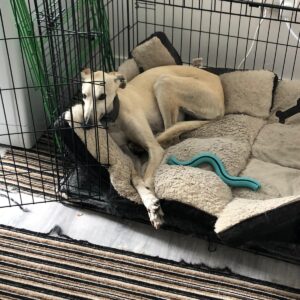Crate training can prove to be tricky. Here is your how to guide for crate introductions.
Please note, this has to be done very gradually over time at your dog’s own personal pace. If he starts to run out of the crate or not want to go in at any time, weve gone too fast and need to go back a step.
• take some high, high value treats- cheese or even some hotdogs warmed slightly in the microwave for the first introduction. Go back to his usual food or treats after this.
• have your dog in another room when prepping this.
• place crate in the centre of the room with the high value treats in the middle of the crate with the door CLOSED
• let your dog into the room; don’t entice or call him to the crate, say nothing to him, just allow lots of sniffing around the crate and let him sniff out the hotdog and want to get into the crate.
• open crate door, when he goes in to retrieve the treats, say “yes” and reward with more treats tossed into the crate.
• reinforce being inside the crate by “feeding the bed” dropping food onto the crate bed and saying “yes” each time your dog takes the food. Don’t lure him in, just drop food on the crate floor and reward with a “yes” marker word each time he goes in. If he leaves, rewards stop, give him a break, and carry on again when he comes back over to the crate. The door is open for the entirety of this training.
• spend some time doing this, take your time
** ALL CRATE INTRODUCTIONS NEED TO BE DONE VERY SLOWLY OVER TIME IN SHORT INCREMENTS ***
• If your dog leaves the crate each time he takes the food, that’s fine. Carry on feeding the base of the crate with dropped food building the positive associations that being in the crate comes with lots of great stuff.
• After a while of doing this. When feeding the base of the crate, ask for relaxed positions from your dog like “sit” and “lie down”. Always reward by “feeding the bed” with dropped food on the base of the crate – reinforcing the crate with positive associations rather than treating your dog directly.
• this is what a first introductory session with the crate will look like.
• Once your dog is able to sit or lie down in the crate comfortably and is not darting in and out then progress to the next step. If he is not able to go in and stay in while you feed the bed, then spend longer at this step.
• Still working with the door open, start to incorporate you moving around the crate
• ask for sit / lie down in the crate . Feed the bed with dropped treats with you sitting or kneeling next to the crate. then stand up and immediately go back to your sitting position next to your dog and reward him for staying in the crate. If he moved with you, that’s fine, take a break and come back to it later. If he stayed in place, repeat moving and reinforcing staying in the crate area and very gradually build time spent standing next to him. Then progress to taking a step away. Next progress to taking a step away and turn around so you’re no longer facing him. Each time he stays in the crate, reinforce this behaviour by dropping food on the bed.
• up until now, the crate door has been open giving your dog the choice and agency to stay in the crate – when introducing a closed crate door with these steps. Start by closing it over and immediately opening it back up and reward with another dropped treat on the bed. Repeat this a few times.
• next, close the crate door over for a count to 2 and open it back up and reward again
• With you beside him, very slowly and gradually build up the time spent in the crate with the door closed over. If at any point he tries to paw the door open, run out or stresses. Stop. Go back a couple of steps.
• when incorporating movement and staying relaxed in the crate, you can work in stimulus like clapping your hands twice or taking a step away and doing a little dance and rewarding your dog for remaining in the crate.
• carry on reinforcing the crate throughout the day by providing enrichment and treat scatters in the crate, outside of training time so your dog has a consistent positive association with the crate.
It helps to break it down to 5 mins of work once or twice a day for a couple weeks and build up slowly to leaving the room and dog happy to remain in the crate at all times. This will also benefit other training as it’s a lovely stress regulation exercise, almost like training meditation for dogs.





